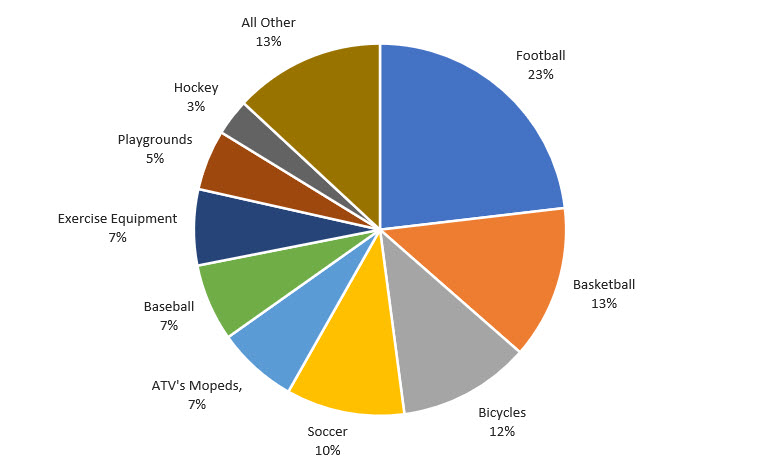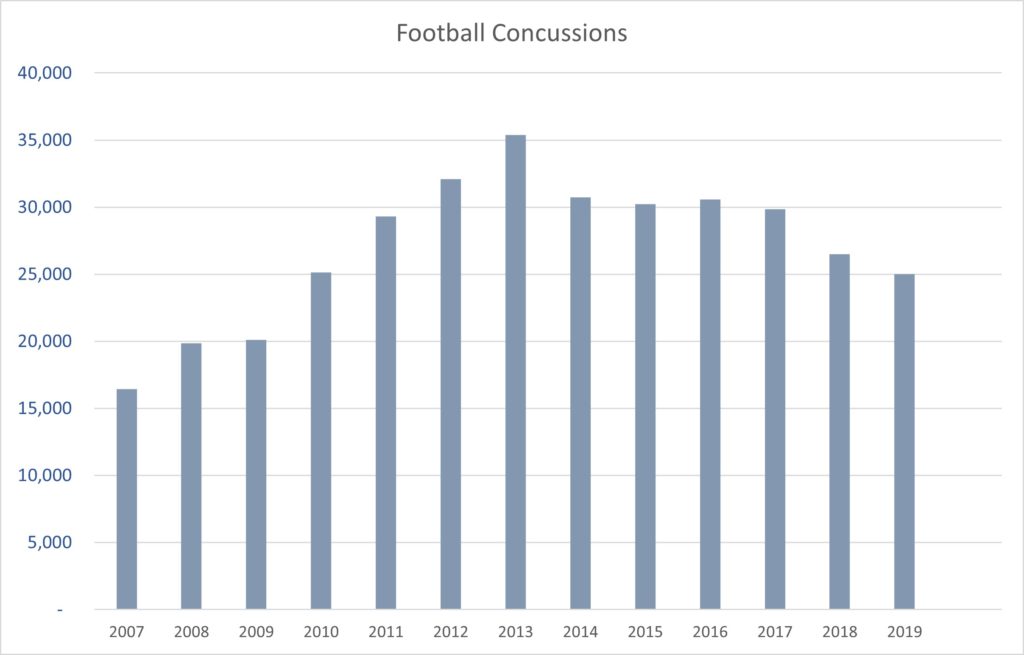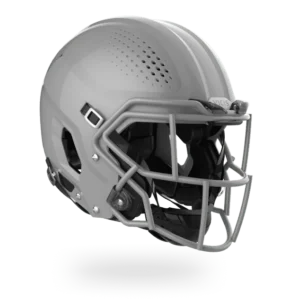Accidental falls are the leading traumatic brain injuries, including concussions, followed by motor vehicle collisions. Sports and recreational activities are also among the leading causes in the US. During the twelve months that ended in December 2019, the following sports and recreational activities were identified as the top ten by the number of cases reported. This report only considers the number of head injuries that occurred over the specified period. It does not rank the safety or degree of danger involved in participating in these sports and activities. The focus of this article is on traumatic brain injuries, but in some cases, the head injuries were not always reported with enough specificity.
Of the 108,043 sports and recreation-related head injuries reported in the US in 2019, football was the leading cause at 23.1%.
Football
Interestingly, the number of concussions reported for football activities increased between 2007 and 2013. Note that the NFL implemented rule changes in 2009 to reduce head and neck injuries. Other leagues from the NCAA down to youth football implemented similar rules and training to protect players. You might ask why the numbers continued to increase for four years after the rule changes at all football levels.
A side benefit of the rule changes among America’s most popular sports is that it raised awareness of the problem. Coaches, trainers, players, and family all began to understand the long-term consequences of traumatic brain injuries, particularly concussions. We suspect a large number of these injuries were either not recognized or went untreated before 2009. After 2009, concussions and traumatic brain injuries became more likely to be identified. More players were treated. And more of these injuries were reported.
Since 2013 the number of concussions, and other traumatic brain injuries, from football have decreased from a high of 35,389. The number of football concussions in 2019 was about 25,000. Even with the 38% decrease, football is still the number one sport for concussions, a form of traumatic brain injury.
Basketball
Although most violent contact is not allowed by rule in basketball, contact is unavoidable in a competitive game. In reality, there is substantial and frequent contact. Like football, professional basketball leagues implemented rules and protocols to protect players from repeated concussions (traumatic brain injuries). The National Basketball Association (NBA) implemented rules in the 2010-2011 season, bringing attention to the matter across other leagues and sports. The basketball rules focus on recognizing concussions then treating and limiting a player’s opportunity to return to play until after the traumatic brain injury has healed sufficiently.
While head injuries are not the most common injury in basketball, 14,377 occurred in 2019.
Bicycles
Cycling, in its various forms, causes the most head injuries of any recreational or sporting activity. The number of head injuries related to bicycles and accessories was 74,452 in 2019 and has reached numbers over 80,000 during several years over the last decade. Fortunately, most of those head injuries are not traumatic brain injuries. In 2019, 12,381 traumatic brain injuries occurred out of a total of 74,452 total head injuries. Most cycling head injuries are contusions, abrasions, and lacerations.
Please check tbi.com for an article about the effectiveness of helmets in reducing traumatic brain injuries for cyclists.
Soccer
While the most common injuries incurred while playing soccer are strains, sprains, fractures, contusions, and abrasions, 11,120 or about 5.5% of soccer injuries in 2019 were traumatic brain injuries. Most were concussions, which are mild traumatic brain injuries. Since soccer is one of the most popular sports in the US and the world, the number of traumatic brain injuries occurring during soccer play is fourth on the list.
An interesting point worth making about concussions in soccer is that there is a long traditioned rule allowing players to use their head to strike the ball (heading), which is one of the leading causes of concussions in soccer. Those relatively mild traumatic brain injuries can become serious when they occur repeatedly. Players, coaches, and officials must learn safe and proper techniques for heading. Young players must be coached and corrected if they are using dangerous techniques. As with any sport, concussions must be recognized when they occur and players removed from play to prevent repeated traumatic brain injuries and severe complications.
ATV’s, Mopeds, Minibikes
 Motorized bikes and All-Terrain-Vehicle accidents were the cause of 7,564 head injuries that required treatment. This number does not include traffic accidents involving motorcycles. These accidents are mainly attributed to offroad use and not necessarily involving a multi-vehicle collision. Numerous accidents occur while these vehicles are used at high rates of speed, causing a loss of control or collision with non-moving objects such as trees, walls, embankments, and other obstacles. In the case of ATV rollover accidents, the victim often hits the ground violently. In many cases, the vehicle itself impacts the rider as they separate from the vehicle.
Motorized bikes and All-Terrain-Vehicle accidents were the cause of 7,564 head injuries that required treatment. This number does not include traffic accidents involving motorcycles. These accidents are mainly attributed to offroad use and not necessarily involving a multi-vehicle collision. Numerous accidents occur while these vehicles are used at high rates of speed, causing a loss of control or collision with non-moving objects such as trees, walls, embankments, and other obstacles. In the case of ATV rollover accidents, the victim often hits the ground violently. In many cases, the vehicle itself impacts the rider as they separate from the vehicle.
While local laws often require helmets and restrict where these vehicles are allowed to operate, these laws are often ignored.
Baseball/Softball
Every organized baseball league requires the use of helmets for players at-bat or running bases. This is primarily to protect the player’s head in case hit by a high-speed ball. A variety of incidents causes head injuries among baseball and softball players. These range from collisions with the ground, collisions with other players, and in some cases, collisions with other objects as players often chase balls outside of the boundaries. While it is rare for a player to be struck by a bat, it does happen occasionally, and the types of helmets worn by baseball players are not designed to protect against a direct hit by a bat.
Most baseball and softball leagues have regulations on the types of bats and balls that may be used. It is clear that certain types of bats are capable of launching the ball at a higher speed than others, and certain balls leave the bat at lower speeds than others. These equipment rules make the game marginally safer. Baseball and Softball accounted for 7,251 head injuries in 2019.
It should also be noted that a softball is not soft, a strike in the head with a softball traveling at high speed after hit by a bat is capable of causing a moderate to a severe concussion.
Exercise & Equipment
This category includes everything from cardio equipment to resistance training to other gymnastic-type equipment. The relatively large number of people of all ages using various exercise equipment may unjustly make this number look large compared to other sports and recreation injuries. However, there were 7,136 reports of falls and mishaps involving exercise using equipment that caused head injuries in 2019. Always consider your skill level and vulnerability when exercising, particularly when starting a new exercise or activity that you have not done recently.
Playgrounds & Equipment
Due to the number of injuries on playgrounds in years past, newer playgrounds are built with a level of safety. You will find soft surfaces and padding where collisions are likely to occur. There is heightened attention to potential injuries when small children are involved. However, aging playgrounds were often constructed before the newer, safer designs and materials were prevalent. Maintenance can be a problem, particularly on older playgrounds. Look for deteriorated padding, missing ground cover, and be aware of sharp edges, rusty parts, or unsafe climbing structures and swings. A total of 5,665 head injuries were reported in 2019 involving playgrounds and equipment.
Hockey
Hockey players move at high speeds on hard ice. The pucks travel at speeds up to 100 miles per hour. Also, fast-moving players on skates are often unable to stop their momentum quickly enough to avoid colliding with another player. While the protective equipment has improved over time, hockey players often sustain various injuries involving bones and joints, but concussions are also one of the common injuries.
Hockey is remarkably safe for players when considering the injury rate is less than 1% of players. However, 12% of hockey injuries are concussion-related. In 2019, 3,410 hockey-related head injuries were recorded.
All Other Sports
Rugby, LaCrosse, Swimming, Racquet Sports, and other sports that didn’t make the top 10 list individually are responsible for a total of 14,139 traumatic brain injuries. Some of these sports do have a non-negligible risk of traumatic brain injuries, but the overall counts may be lower due to fewer participants.
Sources of Data on Head Injuries, Traumatic Brain Injuries, and Concussions:
National Electronic Injury Surveillance System (NEISS) Traumatic Brain Injury & Concussion TBI Data and Statistics









[…] few deaths occur as a result of baseball injuries, however, baseball is among the top 10 sports-related causes of traumatic brain injuries. Cooper’s brain injury was more severe than typical sports injuries and is considered by […]
[…] injury: In some cases, a sports injury is the cause of TBI. The sports that can cause severe head injury include football, soccer, hockey, baseball, boxing, skateboarding, or any other sport that can […]